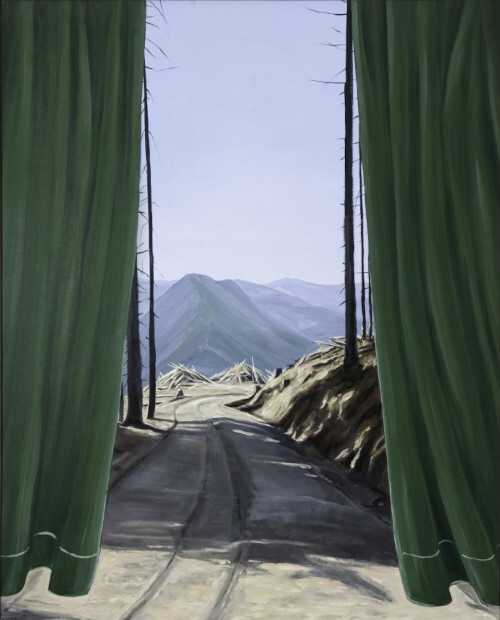The Tree Curtain
The grandeur and beauty of nature is well portrayed in The Tree Curtain, a 2004 painting by Brophy. The painting’s monumental scale brings viewers into the scenery and nature. According to Brophy, he makes larger paintings because they feel more intimate as the scene engulfs the viewer. It feels awe-inspiring as we peek through green curtains that reveal a road with wheel ruts that lead forward and draw our eyes to beautiful green mountains that rise in the background of the painting against a pale blue sky. The finish of the painting is smooth with non-obvious brushstrokes and clear draughtsmanship. Brophy characteristically uses a lot of paint but applies it very thinly to the canvas.
Though beautiful, the painting alerts us that something is off- as is typical for Brophy’s works. We question whether the mountains are just mountains or clear-cut hilltops. We realize that at the end of the road are piles of wood, abandoned and strewn across the road, bordered by dead-looking trees. Dark, brittle, and thin, these trees are melancholic- corresponding to the inspiration for the painting that came as Brophy was traveling on the back roads to the Oregon coast and was startled by the proliferation of clear cut hills he encountered. And in clear cut areas there are also strips of trees called Beauty Strips, and that is what the green curtains in the painting represent according to Brophy- a patch of green that shields the true devastation of clear cutting.
Art historically, curtains were common in the presentation of landscape in the 19th century, such as with Frederic Edwin Church's, Heart of the Andes from 1859- a painting Brophy has been directly inspired by. The motif of curtains also existed in the art of the Renaissance, Dutch Golden Age,and even in the Baroque period of the early 17th century; one such example is the Italian Baroque master Caravaggio’s Death of the Virgin from 1605-1606, transforming a moment of religious significance to a theatrical setting with actors which is exactly what Brophy does. He was inspired by the language of timber workers and the use of ‘show’ to denote timber operations, or ‘staging area’ to refer to the place where trees are stacked. Thus, to Brophy, this theatrical language lended the subject matter to be shown theatrically as well.
By placing the viewer in front of the curtain, we have to decide if we’re the audience facing the stage, on stage, or backstage. We have to think if the curtains are opening for us or closing and we also must think of our place in nature and our individual experience with it as Brophy’s anti-Sublime asks us to consider. Ultimately, the viewer must decide what The Tree Curtain is saying based on our own reflection on the painting’s themes.

